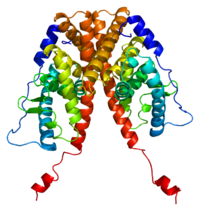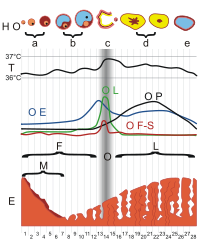
Molecular characterisation of aromatase inhibitor-resistant advanced breast cancer: the phenotypic effect of ESR1 mutations
Sign Up to like & getrecommendations! Published in 2018 at "British Journal of Cancer"
DOI: 10.1038/s41416-018-0345-x
Abstract: BackgroundSeveral thousand breast cancer patients develop resistance to aromatase inhibitors (AIs) each year in the UK. Rational treatment requires an improved molecular characterisation of resistant disease.Materials and methodsThe mutational landscape of 198 regions in 16… read more here.
Keywords: molecular characterisation; breast cancer; resistant tumours; cancer ... See more keywords

Giredestrant reverses progesterone hypersensitivity driven by estrogen receptor mutations in breast cancer
Sign Up to like & getrecommendations! Published in 2022 at "Science Translational Medicine"
DOI: 10.1126/scitranslmed.abo5959
Abstract: ESR1 (estrogen receptor 1) hotspot mutations are major contributors to therapeutic resistance in estrogen receptor–positive (ER+) breast cancer. Such mutations confer estrogen independence to ERα, providing a selective advantage in the presence of estrogen-depleting aromatase… read more here.
Keywords: estrogen receptor; esr1; breast cancer; giredestrant ... See more keywords

Kinome reprogramming is a targetable vulnerability in ESR1 fusion-driven breast cancer.
Sign Up to like & getrecommendations! Published in 2023 at "Cancer research"
DOI: 10.1158/0008-5472.can-22-3484
Abstract: Transcriptionally active ESR1 gene fusions (ESR1-TAF) are a potent cause of breast cancer endocrine therapy (ET) resistance. ESR1-TAFs are not directly druggable because the C-terminal estrogen/anti-estrogen binding domain is replaced with translocated in-frame partner gene… read more here.
Keywords: vulnerability; cancer; esr1; breast cancer ... See more keywords

Abstract PD2-03: Recurrent functionally diverse in-frameESR1gene fusions drive endocrine resistance in breast cancer
Sign Up to like & getrecommendations! Published in 2017 at "Cancer Research"
DOI: 10.1158/1538-7445.sabcs16-pd2-03
Abstract: Background. We previously reported an alternative ESR1 somatic gain-of-function chromosomal translocation event in a patient presenting with aggressive, endocrine therapy resistant estrogen receptor (ER) positive disease, producing an in-frame fusion gene consisting of N-terminal ESR1… read more here.
Keywords: fusion; breast; breast cancer; resistance ... See more keywords

Abstract P6-03-06:ESR1mutant alleles induce differential sensitivity to combination endocrine and targeted therapies
Sign Up to like & getrecommendations! Published in 2020 at "Cancer Research"
DOI: 10.1158/1538-7445.sabcs19-p6-03-06
Abstract: Background: Estrogen receptor alpha (ESR1) mutations in estrogen receptor positive (ER+) metastatic breast cancer drive the development of acquired resistance to endocrine therapy. However, ESR1 mutation status does not currently guide treatment decisions due to… read more here.
Keywords: combination; treatment; esr1 mutant; sensitivity ... See more keywords

Abstract PS17-03: Recurrent activeESR1fusions render a diagnostic transcriptional signature in metastatic breast cancer
Sign Up to like & getrecommendations! Published in 2021 at "Cancer Research"
DOI: 10.1158/1538-7445.sabcs20-ps17-03
Abstract: Background: We recently reported two ESR1 fusions (ESR1-YAP1 and ESR1-PCDH11X) that drive endocrine therapy (ET) resistance and metastasis in estrogen receptor positive (ER+) metastatic breast cancer (MBC) (PMC6171747). Here, we report the functional properties of… read more here.
Keywords: esr1 fusions; fusion; signature; breast cancer ... See more keywords

ESR1 mutations associated with EIS change conformation of ligand receptor complex and alter transcriptome profile.
Sign Up to like & getrecommendations! Published in 2020 at "Endocrinology"
DOI: 10.1210/endocr/bqaa050
Abstract: Estrogen insensitivity syndrome (EIS) arises from rare mutations in estrogen receptor α (ERα, encoded by ESR1 gene) resulting in the inability of estrogen to exert its biological effects. Due to the rarity, mutations in ESR1… read more here.
Keywords: change conformation; receptor; conformation ligand; esr1 ... See more keywords

Disrupted PGR-B and ESR1 signaling underlies defective decidualization linked to severe preeclampsia
Sign Up to like & getrecommendations! Published in 2021 at "eLife"
DOI: 10.7554/elife.70753
Abstract: Background: Decidualization of the uterine mucosa drives the maternal adaptation to invasion by the placenta. Appropriate depth of placental invasion is needed to support a healthy pregnancy; shallow invasion is associated with the development of… read more here.
Keywords: decidualization; gene; severe preeclampsia; esr1 ... See more keywords